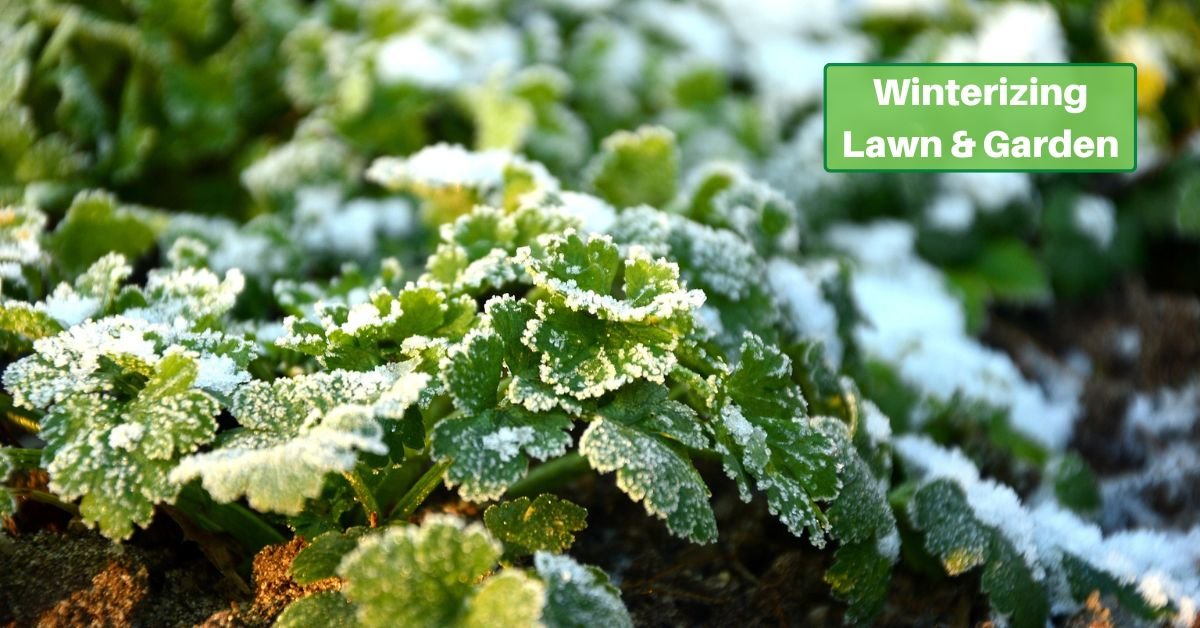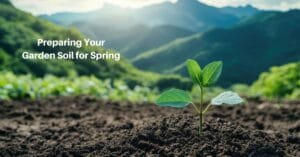Winter’s approach brings a significant shift in the garden’s needs. It’s easy to think of gardening as a spring and summer activity. Still, the steps taken during the colder months are crucial. Winterizing your garden is more than just plant protection; it involves soil quality preservation and preparation for a vibrant spring bloom.
By dedicating time and effort to winterize your garden, you’re not just fighting against frost but nurturing the future health and beauty of your green paradise.
Understanding Your Garden’s Winter Needs
A garden’s winter needs vary significantly based on its location and the specific climate it experiences. Understanding these needs is crucial to ensure your garden’s survival and prosperity through the colder months.
The USDA Plant Hardiness Zone Map is a great place to start. It divides North America into 11 zones based on the average annual minimum winter temperature. Each zone is further split into ‘a’ and ‘b’ segments to provide more precise guidance. Knowing your zone helps select plants best suited to your garden’s climate, thereby increasing their chances of surviving winter.
Climate Variations and Their Impact
Zones 9-11 (Mild Winters): These areas rarely experience frost. Winterizing focuses on maintaining moisture levels and preparing for the cooler, but not freezing, temperatures. Tropical and subtropical plants often thrive here, needing little winter protection.
Zones 7-8 (Moderate Winters ): Occasional frosts are expected, but prolonged freezing temperatures are rare. If you’re in these zones, focus on protecting sensitive plants on frosty nights and managing water to prevent root rot in the cooler, wetter weather.
Zones 4-6 (Cold Winters): These zones are characterized by regular frost and occasional sub-zero temperatures. You’ll want to winterize by protecting perennials with mulch, ensuring adequate soil drainage to prevent freeze-thaw damage, and selecting hardy plant varieties.
Zones 1-3 (Very Cold Winters): These zones experience harsh winters with extended periods of deep frost and snow. If you live here, select extremely hardy plants and use strategies like snow insulation and windbreaks to protect the garden.
Microclimates
Even within your garden, microclimates can exist. Areas near buildings, under trees, or in exposed positions can have different conditions from the general climate zone. These microclimates can affect how plants respond to winter and should be considered when planning winter protection.
Understanding these diverse needs is vital for effective winterizing. It lets you tailor your approach so your plants get the appropriate care to thrive in spring.
Preparing the Soil for Winter
The cornerstone of a healthy garden lies beneath the surface – the soil. As winter approaches, soil testing becomes an invaluable tool. Knowing the soil’s pH and nutrient levels will guide you on what amendments are needed. Organic materials like compost can replenish the soil, promoting a healthy ecosystem for spring growth.
Another critical aspect of soil preparation is mulching. A generous layer of mulch acts as an insulating blanket, protecting plant roots from freezing temperatures and reducing water loss. Materials like straw, leaves, or bark chips are effective mulching options. Mulching also helps prevent soil erosion and suppresses weed growth, making spring gardening easier.
Plant Care and Protection
Caring for plants during winter is a nuanced process. It varies greatly depending on the type of plants you have in your garden. Each category requires specific attention to ensure they survive and thrive through the winter months.
Perennials
These plants are the mainstays of many gardens. Their name references their ability to survive year after year.
Most perennials should be trimmed back dead foliage that can harbor diseases and pests. However, it’s beneficial for some species to leave the dead foliage as it can provide natural insulation. Be sure to look up the type of plant you have to find the best practices.
Apply a thick layer of mulch around the base of perennials to protect their roots from extreme temperature fluctuations. For delicate perennials, consider using burlap or frost cloths for added protection.
Annuals and Delicate Species
As the name suggests, annual plants live for only one season and typically can’t withstand freezing temperatures. In regions with mild winters, some annuals might survive outdoors. In colder climates, though, it’s best to treat them as disposable or move them indoors if they are in containers.
For more delicate species, such as tropical plants or tender bulbs, digging them up and storing them in a cool, dry place over winter is often the best approach. This could involve storing bulbs in a paper bag filled with peat moss or moving potted tropical plants indoors.
Trees and Shrubs
Trees and shrubs require a different approach.
Young or recently planted trees are most vulnerable during winter. Wrapping the trunk in a tree wrap can prevent sunscald and frost cracks. Also, consider applying a layer of mulch around the base to insulate the roots.
For shrubs, particularly those that are evergreen or have delicate branches, a windbreak or shelter can prevent damage from heavy snowfall or strong winds. Pruning dead and diseased branches before winter can prevent potential damage from snow and ice accumulation.
Special Care for Roses and Vulnerable Plants
Roses and other vulnerable plants often need extra attention during winter.
For roses, mound up soil or mulch around the base of the plant, and consider using a rose cone for additional protection. Plants in containers, which are more susceptible to freezing, should be moved to a protected area, like a garage or indoors if possible.
Climbing and Vining Plants: These plants can be susceptible to wind damage. Secure them to their supports, and consider covering them with burlap or similar protective material to shield them from harsh winds.
By giving each type of plant the specific care and attention it needs, you can help ensure that your garden will emerge from the winter season healthy and ready to grow.
Watering Strategies for Winter
Contrary to popular belief, plants still require water during winter. Their needs are less than in summer, but they’re still real. The key is to water deeply but infrequently, promoting strong root growth. This approach also reduces the risk of waterlogging, which can be especially harmful during colder months. Tools like drip irrigation systems can provide consistent, controlled watering without over-saturating the soil.
Managing Pests and Diseases
Winter may seem like a time for gardens to be free from pests and diseases. Still, several can be particularly problematic during this season. Effective management of these pests is crucial for the health and longevity of your garden.
Rodents (Mice and Voles)
When other food sources are scarce, rodents may chew on tree bark, roots, and bulbs during winter. To deter them, keep your garden free of debris where they can hide, and consider setting up traps or barriers. Wrapping the bases of trees and shrubs with wire mesh can prevent these rodents from gnawing on the bark.
Aphids and Mites
Some species of aphids and mites can survive in colder climates and continue to infest plants during winter. They are often found on indoor plants or in greenhouses. Regularly inspecting your plants and using insecticidal soap or neem oil can control these pests.
Deer and Rabbits
These animals can cause significant damage to gardens in winter as their regular food sources diminish. They tend to feed on twigs, bark, and foliage, which can harm or kill young plants. Physical barriers like fencing or commercial repellents can help keep these animals at bay.
Fungal Diseases
Cold and wet conditions are conducive to developing certain fungal diseases, such as powdery mildew and root rot. Ensuring good air circulation and avoiding overcrowding of plants can help prevent these issues. If signs of fungal disease are spotted, remove the affected parts and apply a suitable fungicide.
Slugs and Snails
Snails and slugs are active during wet conditions, which can be prevalent in winter in some climates. They feed on young plants and seedlings, potentially destroying new growth. Use slug and snail baits or natural deterrents like eggshell barriers or diatomaceous earth to keep them away from your plants.
Scale Insects
These pests include mealybugs and can infest trees and shrubs during winter, feeding on sap and weakening the plants. Look for small, bumpy protrusions on branches and leaves – a telltale sign of scale insects. Horticultural oil sprays can be effective, especially when applied during dormant periods.
By being vigilant and taking proactive measures against these common winter pests, you can significantly reduce the risk of infestations and plant damage. This protection is critical to ensuring that your garden remains healthy and robust, ready for the resurgence of growth in spring.
Winter Tools and Equipment
Equipping yourself with the right tools and equipment is essential for effective winter garden care. Proper selection, maintenance, and storage of these tools make winterizing tasks easier and ensure their longevity and readiness for the upcoming gardening seasons.
Pruners and Shears
Sharp, well-maintained pruners and shears are indispensable for cutting back perennials, shaping shrubs, and removing dead or diseased branches from trees. Use bypass pruners for live plants and anvil pruners for deadwood. Keeping these tools sharp and clean prevents disease spread and makes cutting easier.
Mulching Materials
A good supply of mulching materials, such as straw, shredded leaves, or bark chips, is crucial for insulating plant roots and preserving soil moisture. A wheelbarrow or garden cart can be very helpful for transporting these materials around your garden.
Frost Cloths and Burlap
For protecting sensitive plants from frost, have a stock of frost cloths or burlap. These materials provide insulation while allowing moisture and light to reach the plant.
Watering Systems
Even in winter, some watering is necessary. A reliable watering can, a garden hose with a shut-off nozzle, or a soaker hose system helps provide your plants with the needed water without overdoing it.
Garden Rake and Shovel
A sturdy rake is handy for clearing leaves and debris. You’ll use a shovel to dig up tender plants or bulbs for storage.
Protective Gear
Don’t forget personal protective equipment. Durable gloves protect your hands from thorns and cold, while knee pads or a kneeling mat provide comfort during ground-level tasks.
Storage and Maintenance
Proper storage of garden tools is vital. Clean them after each use to remove soil and plant debris. Sharpening blades and oiling moving parts will keep them in good working condition. Store them in a dry, secure place to prevent rust and deterioration. Organizing tools in a garden shed or garage using hooks or shelves keeps them accessible and in good condition.
Winterizing your garden is a vital process that sets the foundation for a flourishing spring, and this guide will help you make it through gardening’s off-season. Winter may offer a slower time, but there’s still much to be done around your garden. Embrace the time as an opportunity to prepare for spring!









